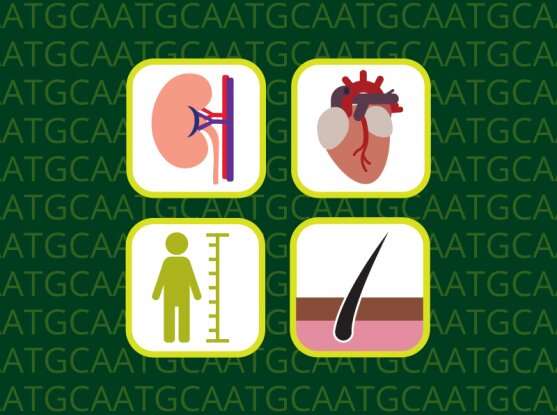
New study finds that a type of genetic modification involving long, repeated sequences within the human genome can affect a variety of health-related traits.
Over the last decade, geneticists studying how variations in DNA sequence between individuals can influence disease risk and other traits have largely focused on one type of variation: single-letter changes. Now a new study reveals how larger genetic modifications also significantly contribute to human traits.
The study, from researchers at the Broad Institute of MIT and Harvard, Brigham and Women’s Hospital, and Harvard Medical School, found that genetic changes called variable number tandem repeats (VNTRs) are strongly associated with nearly two dozen traits, including height, hair curl, and risk for heart and kidney disease. VNTRs are sections of the genome that stretch from seven up to thousands of base pairs in length, and are repeated a varying number of times in different individuals.
The team expected to see some associations between VNTRs and traits, but were surprised by how strong those links were. “The VNTRs we studied wound up being the top or second biggest genomic contributor to a trait,” said Po-Ru Loh, an associate member of the Broad Institute, an assistant professor at Harvard Medical School, and co-senior author of the study. “That really was a surprise.”
The results, published in Science, pave the way toward a deeper genetic understanding of how genetics affects human traits and disease, and also point to a new way for scientists to study larger-scale genetic repeat variation.
A view into VNTRS
The role of larger genomic alterations such as VNTRs has been understudied over the last decade. Because VNTRs are larger and more complex changes, the usual methods used to study genetic variation have missed the contribution of VNTRs to human characteristics.
To address this, Loh’s lab developed new tools to analyze human exome sequencing data and examine potential VNTRs. In collaboration with Steve McCarroll, institute member of the Broad, director of genomic neurobiology at the Broad’s Stanley Center for Psychiatric Research, and professor at Harvard Medical School, they homed in on 118 VNTRs in the protein-coding region of the human genome. They assessed whether length variation within these VNTRs was associated with traits by studying genetic data from about 415,000 participants in the UK Biobank.
The researchers found that five of the VNTRs contributed to a multitude of traits, often exhibiting strong associations that had not been previously reported. One of the VNTRs was in the LPA gene, which encodes lipoprotein(a) and has been associated with risk of cardiovascular disease. The team’s analysis was able to dissect the way in which this VNTR, together with other variants in LPA, accounts for 90 percent of the heritable variation of lipoprotein(a) levels.
The team also found that a VNTR in the ACAN gene, which encodes a component of cartilage, was associated with height. VNTR length differences in this gene appeared to modify height by as much as 3.2 cm. “Our findings show that there can be really potent effects from these VNTRs,” said Bob Handsaker, a research scientist in the McCarroll lab and co-first author of the study. “It’s more evidence that these complex regions of the genome can be really important and need more study.”
One limitation of the study is that the population in the UK Biobank is mostly of European ancestry. The authors point out that studying data from a more diverse cohort will be necessary to learn more about the role of large-scale genetic changes like VNTRs. Studying the DNA of people with disease will also be important. “It will be really interesting to explore the VNTRs in other cohorts that are enriched for particular biological outcomes like certain diseases,” said Ronen Mukamel, a postdoctoral researcher in Loh’s lab and co-first author of the study.
Additionally, all of the 118 VNTRs the researchers studied were in protein-coding regions of the genome. They say that studying VNTRs in other areas of the genome such as non-coding regions, which regulate gene expression, will also be essential in understanding how VNTRs influence human traits.
Source: Read Full Article
